Surface metrology has to gradually deal with the existence of sub-micron thick films, which are currently being used on products other than semiconductor devices. Sub-micron films may be incidental – for example, oil on a machined part – or may not be very significant to users who are interested only in the top surface. However, the film may also be crucial, offering precise optical features or protecting the underlying substrate.
In any situation, introducing a sub-micron film to a component seldom eases prior surface metrology requirements. Such requirements will frequently expand to comprise film properties such as thickness, texture, and uniformity.
Requirements for Surface Films Analysis
Ideally, a surface metrology technology created to establish sub-micron films will be able to retain its performance only for topography. This includes metrics such as resolution and throughput and even extends to configuration flexibility. With regard to microscope-based technologies, this would mean that surface films analysis should not restrict the choice of zoom or objective.
Reliable 3D Surface Metrology in Adverse Conditions
As for the films metrology itself, it is vital that related calibrations are sample-agnostic – a calibration artefact that is specific to a sample, for example a matching bare substrate may be either costly or impractical. It is ideal if measurements leverage the available optical resolution: surface metrology that was previously generating high-resolution height maps should do likewise for thickness. Eventually, surface films analysis should be able to provide definite results across a wide thickness search range. Users may not know a great deal about thickness, or thickness may differ broadly over the measurement area.
The Challenge and Opportunity for Coherence-Scanning Interferometry
Coherence scanning interferometry (CSI) provides non-contact areal topography maps with sub-nm precision [1][2] across a vast number of surface types, such as flat panel display components [3][4], MEMS devices, automotive machined metal parts [5] , patterned semiconductor wafers, and transparent film structures. CSI measures surface topography from the localized coherence signal produced by interference between reflections from the sample and a reference surface. A standard CSI signal for a bare surface (that is no film) is depicted in Figure 1(a): surface location essentially corresponds to the peak envelope position.

Figure 1. Typical CSI signals for (a) bare surface (no film); (b) thick film (well over 1 µm) with well separated signals from surface and substrate; and (c) sub-micron film with merged surface and substrate signals.
Generally, a transparent film will produce an extra signal from the substrate. In the case of thick films (Figure 1(b)), the signals are appropriately divided and can be conveniently assigned to the substrate and top surface [6][7]. Conversely, for sub-micron films, the surface and substrate signals join together (Figure 1(c)) and cannot be separated. This sensitivity to films also presents a new prospect: the distorted CSI signal can be decoded by modeling the film effects, allowing simultaneous measurement of surface and thickness.
Model-Based CSI
Previous Approaches
Model-based CSI reproduces signals over a predicted range of film properties and selects the best possible match with the measured signal. It has been exhibited in different forms [8][9][10][11][12], all using frequency-domain analysis to combine models for the system and of the part being determined.
There is a stipulation with model-based CSI: it is imperative that film properties are at least partially known, to bind the search space and avoid degenerate solutions. In fact, this frequently needs to be known for visible-spectrum refractive indices for film as well as substrate, with the thickness of the film left as the unidentified parameter to be assessed.
In earlier model-based approaches, there were practical compromises between field of view and throughput due to intensive computation, and frequently precluded the use of high-NA objectives. Due to the precursor to the technique described here, high-NA measurement of samples with complex reflectivity is attained [13][14][15] , by means of a system model derived from the objective pupil to build signal libraries across the broad search range (Figure 2). A specialized Bertrand tube-lens is essential to conduct the pupil calibration.
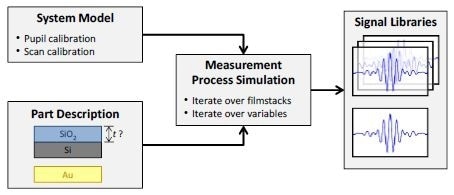
Figure 2. Signal library generation, combining a system model handling arbitrarily high NA with a model of the part being measured.
Presented Approach
While the technique shown here is similar in principle to its predecessor [13], it separates calibration into two parts: an on-tool component and a nominal pupil calibration performed with the ideal measurement configuration. The procedure uses only standard CSI hardware and can be used with any interferometric objective. The whole measurement sequence is shown in Figure 3.
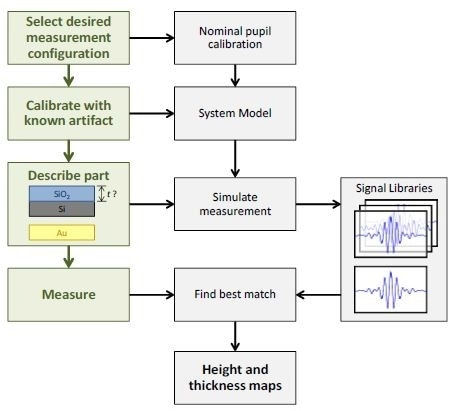
Figure 3. Measurement flow for presented approach. Steps performed by the user are shown in green.
The ideal-match signal search stays technically unaffected, with the main difference that optimized processing – allowed by greater computing power – currently facilitates full-field analysis at megapixel camera formats. While processing time largely depends on the pixel count and search range, it is typically under 10 seconds for full-field analysis. Any flat artifact with known visible-spectrum refractive indices are employed for calibration. There is a need for no part-specific calibration, which is commonly beneficial for parts with reverse engineering or complex geometries.
Example Measurements
Various types of parts with sub-micron films and dissimilar materials were measured using a contemporary commercial CSI microscope [16]. For each measurement configuration, a silicon carbide flat was used to execute calibration. This silicon carbide flat is also used for standard-CSI calibrations.
Films Applications Requiring a Wide Search Range
All model-based techniques have a certain degree of degeneracy that can produce a number of solutions to the same set of model parameters. Regarding films metrology, the result can be ambiguous or incorrect film thickness values that create seemingly acceptable matching signals to the experimental data. Restricting the thickness search range can provide a solution, but this may be precluded by insufficient knowledge or by enormous differences in thickness over the measurement area. A more smart option is to detect small yet clear signal details that make it possible to eliminate potential degenerate solutions and allow for an extensive search range.
Figure 4 shows a silicon substrate coated with silicon oxide with center thickness ~1.2 µm. The outer rim of the coating has a thickness gradient down to zero (bare silicon), where the fixture masks the substrate during evaporation. A 20X Mirau objective was used to measure this transition region, using an oxide-on-silicon model with a search range of 0 to 1300 nm, and individual processing for all pixels in the field of view.

Figure 4. Oxide-gradient sample measured at the film boundary using a 20X Mirau objective. The thickness map ranges from 0 (bare silicon) to ~1.2 µm. The substrate profile, derived by subtracting thickness from the top surface, is flat to ~1 nm.
The resulting thickness map and a cross-sectional slice covering the entire thickness range are also seen in Figure 4. As anticipated, the difference in thickness is continuous and monotonic and reveals that the thickness was clearly determined throughout the wide search range. As estimated, the silicon substrate derived by subtracting thickness from the top surface is flat and within ~1 nm.
Films Metrology over a Wide Range of Magnification
The large options for CSI magnifications enable a wide range of surface metrology applications, from measuring form to examining microscopic defects. This flexibility, with the inclusion of thin films, remains just as attractive, and hence should extend to film’s metrology itself. Model-based CSI must preferably function across the whole selection of optical configurations.
Figure 5 shows thickness maps, which are established for an oxide-on-silicon film standard (NIST certified thickness of 96.6 ± 0.4 nm) using four different combinations of zoom/objective covering a 70X range in magnification.
For all experiments, analysis used an oxide-on-silicon model with a search range of 0 to 1200 nm for all pixels in the field of view. The wide search range is deliberate so as to confirm robustness as well as imitate the case of film thickness being unknown.
A full picture of film attributes is provided by the broad range of magnifications. The 1.4X Zygo Wide Field (ZWF) objective [19] is able to capture the entire certified region in a single field of view and shows slow variations in film thickness. Furthermore, the concentric rings match the deliberate patterning in the film, and black rings specify where the oxide is etched down to the silicon substrate. Measurements done at higher magnifications reveal smaller-scale thickness differences and even surface scratches that result from handling this laboratory sample. Details of individual striation defect were shown by the maximum-magnification map, which, in turn, was accomplished with a 50X Mirau.
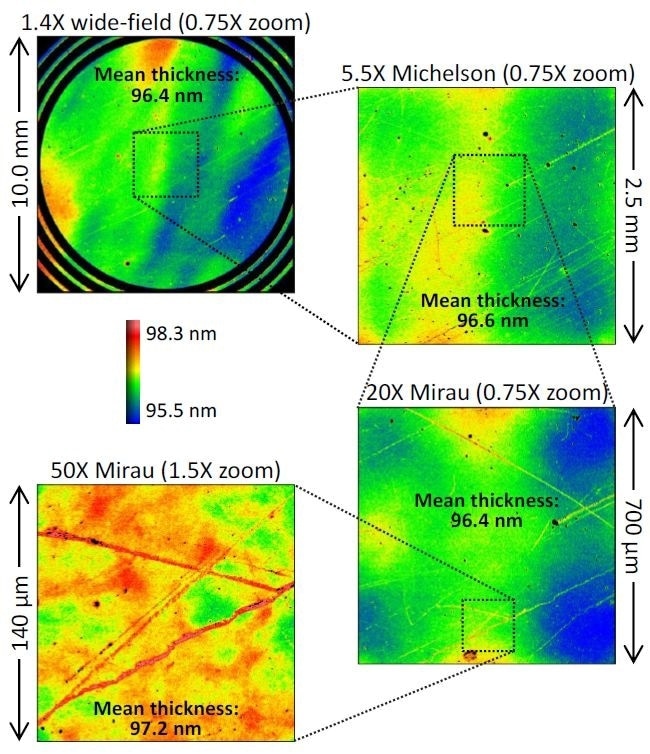
Figure 5. Thickness maps for an oxide-on-silicon film standard (certified thickness 96.6 nm), measured over a 70X range of magnification. The agreement in mean thickness is better than 1 nm across all objectives.
Model-based CSI provides surface maps, along with the thickness maps as shown in Figure 4. Subtracting the thickness of film from the top surface develops a derived map of the substrate surface. Together, these maps allow for extra validation and metrology. The range of magnifications enables complete surface analysis.
Results acquired from the 1.4X ZWF capture the regions of the exposed silicon substrate as well as the oxide film (Figure 6). Steps between the oxide and bare silicon are illustrated by the surface map. From the manufacturing sequence (blanket thermal oxidation followed by patterned etch down to silicon substrate), surface steps are predicted to match the film thickness, or equivalently that the underlying silicon substrate should stay continuous. This is established by the substrate map, corroborating the overall measurement.
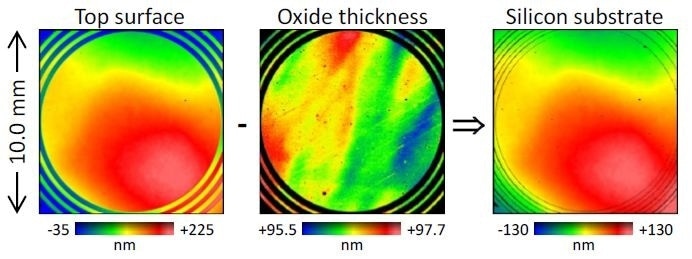
Figure 6. Surface, thickness, and substrate maps for oxide-on-silicon film standard measured using a 1.4X ZWF objective
Measurements done at higher magnification reveal textural variations between the substrate, surface, and thickness. Interface maps attained from the 20X Mirau, with form (4th-order polynomial) removed is illustrated in Figure 7. The top surface reveals both striations and orange-peel texture. Meanwhile, the film texture is controlled by striations while the substrate displays orange-peel texture but without any striations. These maps reveal that the orange-peel texture is contributed by the substrate and the striations exist in the film’s top surface (perhaps from usage, and not an original defect).
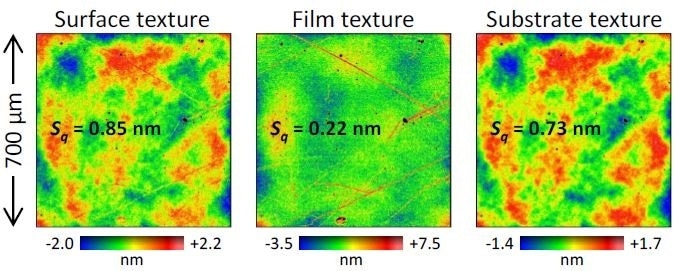
Figure 7. Maps for oxide-on-silicon film standard measured with a 20X Mirau objective, with form removed to reveal texture.
Parts with Dissimilar Materials
If there are differences in phase-change on reflection (PCOR), even bulk materials can confound traditional CSI as will occur between different materials [13]. For example, a traditional CSI measurement of a metal/glass step will be biased by ~10 to 20 nm, with the metal appearing lower than in reality [18].
Traditionally, a part can include both films and bulk dissimilar materials. The fabrication sequence for such a sample is illustrated in Figure 8, in the form of trenched oxide-on-silicon with a partial gold overcoat.
First, a silicon substrate was used on which approximately 1 µm of thermal silicon oxide was grown. Then, trenches were developed in the oxide via photoresist masking and a partial etch, and thinner oxide were purposely left at the bottom of the trench. Lastly, trenches were partially gold-coated by a lift-off sequence (photoresist masking, global gold deposition, photoresist strip). Target gold thickness was about 90 nm, which was sufficient to prevent film effects from the underlying oxide.

Figure 8. Fabrication sequence for oxide trench sample with partial gold overcoat: (a) grow ~1 µm of thermal oxide on a silicon substrate; (b) form oxide trench; (c) deposit partial gold overcoat.
This sample was established using a 50X Mirau objective, with analysis tailor-made to each region: an oxide-on-silicon model with a search range of 0 to 1200 nm was used for the uncoated oxide and bulk-gold model (i.e. no film) was used for the gold overcoat. Thickness and surface maps for a pair of trenches over a gold-coating boundary can be seen in Figure 9.
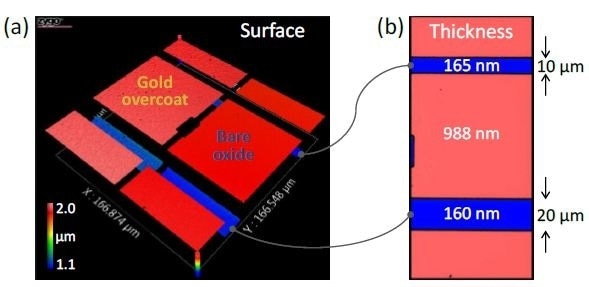
Figure 9. Maps for (a) surface and (b) bare-oxide thickness of trench-oxide sample, measured using a 50X Mirau objective
The thickness of the unetched oxide was established and discovered to be 988 nm. For the trenches, thickness marginally relies on their width: 160 nm for the 20-µm trench and 165 nm for the 10-µm trench. By subtraction, thickness results reveal a trench depth of 828 nm and 823 nm for the 20-µm trench and 10-µm trench, respectively.
This is verified by the results illustrated in Figure 10, which shows cross-sectional surface-map profiles via both trenches, and on either sides of the coating boundary, that is, with and without gold overcoat. The trench depths measured in this manner, agree with thickness-suggested results to better than 1 nm.
In general, thickness and surface results demonstrate that the oxide-etch process was about 0.6% slower in the narrower 10-µm trench. On additional verification, it was observed that trench-depth measurements on both sides of the coating boundary – attained using independent analyses with and without film effects – agree to better than 1 nm.
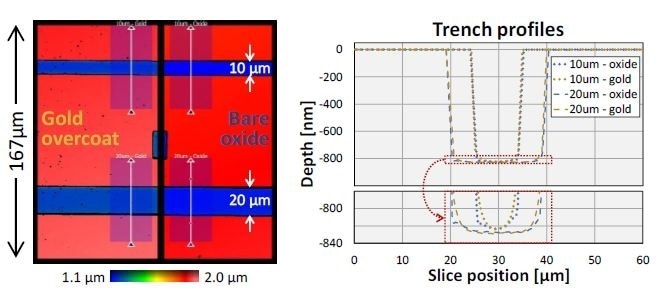
Figure 10. Profiles for trenches with width 10 µm and 20 µm, measured on opposing sides of gold-coating boundary. Measured trench depth agrees to better than 1 nm across the gold-overcoat boundary. The 10-µm trench is ~5 nm shallower than the wider 20-µm trench, consistent with its oxide thickness measuring as 5 nm thicker (Figure 9(b)).
There are some applications where precise topography is required across dissimilar regions. For this type of sample, it corresponds to the gold thickness step across the coating boundary.
Figure 11 shows gold-thickness profiles that were established over dissimilar thicknesses of oxide films: 160 nm inside the 20-µm trench and 988 nm in adjacent unetched oxide. Both profiles exhibit a gold thickness of about 85 nm with agreement to ~1 nm.

Figure 11. Step profiles across gold-coating boundary, measured within the 20-µm trench and on adjacent unetched oxide. Measured gold thickness agrees to about 1 nm.
Conclusion
This article explains how the approach to model-based CSI allows for full-field films surface metrology across a whole range of interferometric objective magnification and produces high-resolution maps of film and surface thickness. Calibration is sample-agnostic, and measurement time for most practical search ranges is comparable to that of conventional CSI. Model-based CSI, beyond transparent films, offers PCOR-corrected topography for all combinations of dissimilar materials with recognized visible-spectrum refractive indices, including metals.
Furthermore, results reveal single-nm self-consistency between topography maps and thickness, if refractive indices are well established. This offers a key caveat with model-based CSI: insufficient knowledge of material properties will limit performance, and can even hinder a meaningful measurement. For model-based CSI, a natural next step would be to extend capabilities to endure uncertainty in material properties.
Acknowledgments
The original work presented in this paper benefited from key contributions and input from Xavier Colonna de Lega, Jim Kramer and Peter de Groot.
References
[1] de Groot, P., “Principles of interference microscopy for the measurement of surface topography”, Advances in Optics and Photonics 7 (1), 1-65 (2015).
[2] ISO, [25178-604:2013(E): Geometrical product specification (GPS) – Surface texture: Areal – Nominal characteristics of non-contact (coherence scanning interferometric microscopy) instruments] International Organization for Standardization, Geneva (2013).
[3] Grigg, D., Garden, R., Mino, M., Lu, H., and de Groot, P., “New optical metrology techniques for color filter inspection and process control”, Proc. IDW 11th international display workshops, Niigata, Japan (2004).
[4] He, Z., Zheng, J., Garden, R., de Groot, P., “New optical 3D-CD metrology techniques for liquid crystal display manufacture inspection and process control”, Proc. Asia Display, Shanghai, China (2007).
[5] Wyant, J. C., “How to extend interferometry for rough-surface tests”, Laser Focus World, 131-135 (1993).
[6] Flournoy, P. A., McClure, R. W., and Wyntjes, G., “White-light interferometric thickness gauge”, Appl. Opt. 11, 1907 (1972).
[7] Colonna de Lega, X. and de Groot, P., “Transparent film profiling and analysis by interference microscopy”, Proc. SPIE 7064, Interferometry XIV: Applications, 70640I (11 August 2008).
[8] de Groot, P., “Method and apparatus for surface topography measurement by spatial-frequency analysis of interferograms”, US Patent No. 5,398,113 (14 March 1995).
[9] de Groot, P.J. and Colonna de Lega, X. “Signal modeling for low-coherence height-scanning interference microscopy”. Appl. Opt., 43, 4821-4830 (2004).
[10] Kim, S.-W. and Kim, G.-H. “Thickness-profile measurement of transparent thin-film layers by white-light scanning interferometry”, Appl. Opt. 38, 5968 (1999).
[11] D. Mansfield, “The distorted helix: thin film extraction from scanning white light interferometry,” Proc. SPIE 6186, paper 23 (2006).
[12] D. S. Wan, “Measurement of thin films using Fourier amplitude,” US Patent No. 7,612,891 (3 November 2009).
[13] de Groot, P. and Colonna de Lega, X., “Optical Topography Measurement of Patterned Wafers”, AIP ULSI Conference Proceedings 788, 432 (2005).
[14] Colonna de Lega, X., “Generating model signals for interferometry”, US Patent No. 7,619,746 (17 November 2009).
[15] Colonna de Lega, X. and de Groot, P., “Characterization of materials and film stacks for accurate surface topography measurement using a white-light optical profiler”, Proc. SPIE 6995, 69950P (2008).
[16] Zygo Corporation, [Nexview Optical Profiler], Specification sheet SS-0095 09/12 (2013).
[17] Biegen, J. F., “Determination of the phase change on reflection from two-beam interference”, Opt. Lett. 19, 1690-1692 (1994).
[18] Park, M.-C. and Kim, S.-W., “Compensation of phase change on reflection in white-light interferometry for step height measurement”, Opt. Lett. 26, 420-422 (2001).
[19] de Groot, P. and Biegen, J.F., “A new class of wide-field objectives for 3D interference microscopy”, Proc. SPIE 9525, Optical Measurement Systems for Industrial Inspection IX, 95250N (2015).
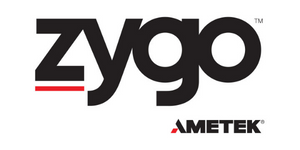
This information has been sourced, reviewed and adapted from materials provided by Zygo Corporation.
For more information on this source, please visit Zygo Corporation.